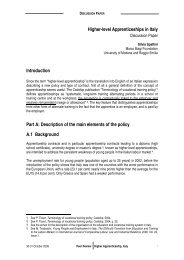The Active Labour Market Policy Reform – The Second Wave
The Active Labour Market Policy Reform – The Second Wave
The Active Labour Market Policy Reform – The Second Wave
You also want an ePaper? Increase the reach of your titles
YUMPU automatically turns print PDFs into web optimized ePapers that Google loves.
May 13-14, 2004<br />
EXECUTIVE SUMMARY<br />
During the interim period between the two phases of reforms, it became clear that a more<br />
radical response to the labour market and fiscal pressures was necessary. <strong>The</strong> two-strand<br />
second labour market reforms were introduced.<br />
<strong>The</strong> First Strand: Joint Service Centres<br />
<strong>The</strong> main instrument developed to combat structural unemployment was the Joint Service<br />
Centres (JOIS). <strong>The</strong> pilot programme was set up in 2002 and 25 centres were opened,<br />
mainly in the larger cities and towns but covering the whole country fairly comprehensively.<br />
<strong>The</strong> idea behind the JOIS was to stop sending customers from one institution to another and<br />
to find joint solutions. <strong>The</strong> main aim was to create one-stop-shops for hard-to-place people<br />
who needed more services than just those of the PES, i.e. those of the municipalities and<br />
the national insurance institution (Kela) as well. Concrete targets were to help at least 60 %<br />
of the customers to find more permanent solutions to their problems and to reduce the<br />
number of joint beneficiaries of labour market support and social assistance. <strong>The</strong> JOIS<br />
funding was shared 50:50 between the state and the municipalities but thus will need to be<br />
reappraised in future.<br />
As well as providing holistic assessment and services, the JOIS also acted as a ‘gateway’ for<br />
other services needed by the customers, e.g. rehabilitation, health, work experience, drug<br />
detoxification, youth workshops, etc. <strong>The</strong>se services were sub-contracted from<br />
municipalities, the third sector, private organisations and enterprises.<br />
<strong>The</strong> centres were extremely well received by customers and the staff reported a high degree<br />
of job satisfaction. <strong>The</strong> mid-term evaluation of the pilot project (Arnkil et al., 2003) pointed to<br />
a number hiccups at management level due to the complexity of managing a centre under<br />
three different administrations (state, municipalities, insurance institution). <strong>The</strong>re was also a<br />
certain ‘culture clash’ between the bodies involved (e.g. social workers found the labour<br />
market officials too labour market-oriented while labour market officials found the social<br />
workers too ‘different’ and too slow to push people towards employment), and one<br />
organisation usually dominates.<br />
In 2001, new legislation on active social policy was brought in, requiring new forms of cooperation<br />
between employment offices and municipalities, and the scheme was taken<br />
forward in the new national government employment programme and the new employment<br />
service strategy under the title of <strong>Labour</strong> Force Service Centres (LAFOS). 15 centres have<br />
been set up to date. 10 of the JOIS are still running. A total of 40 LAFOS are planned in the<br />
strategy period 2004-2006. Although the setting up of a LAFOS is based on an application to<br />
the Ministry of <strong>Labour</strong> and a set of guidelines, each LAFOS is free to design a structure<br />
which corresponds to the needs of its customers.<br />
<strong>The</strong> <strong>Second</strong> Strand: Renewing the Employment Offices<br />
<strong>The</strong> renewal of the employment offices has the following aims:<br />
- Better anticipation of labour market circumstances<br />
- Better employer contacts<br />
- Proactive regional and local role<br />
Peer Review <strong>The</strong> <strong>Active</strong> <strong>Labour</strong> <strong>Market</strong> <strong>Policy</strong> <strong>Reform</strong> <strong>–</strong><br />
<strong>The</strong> <strong>Second</strong> <strong>Wave</strong><br />
5





